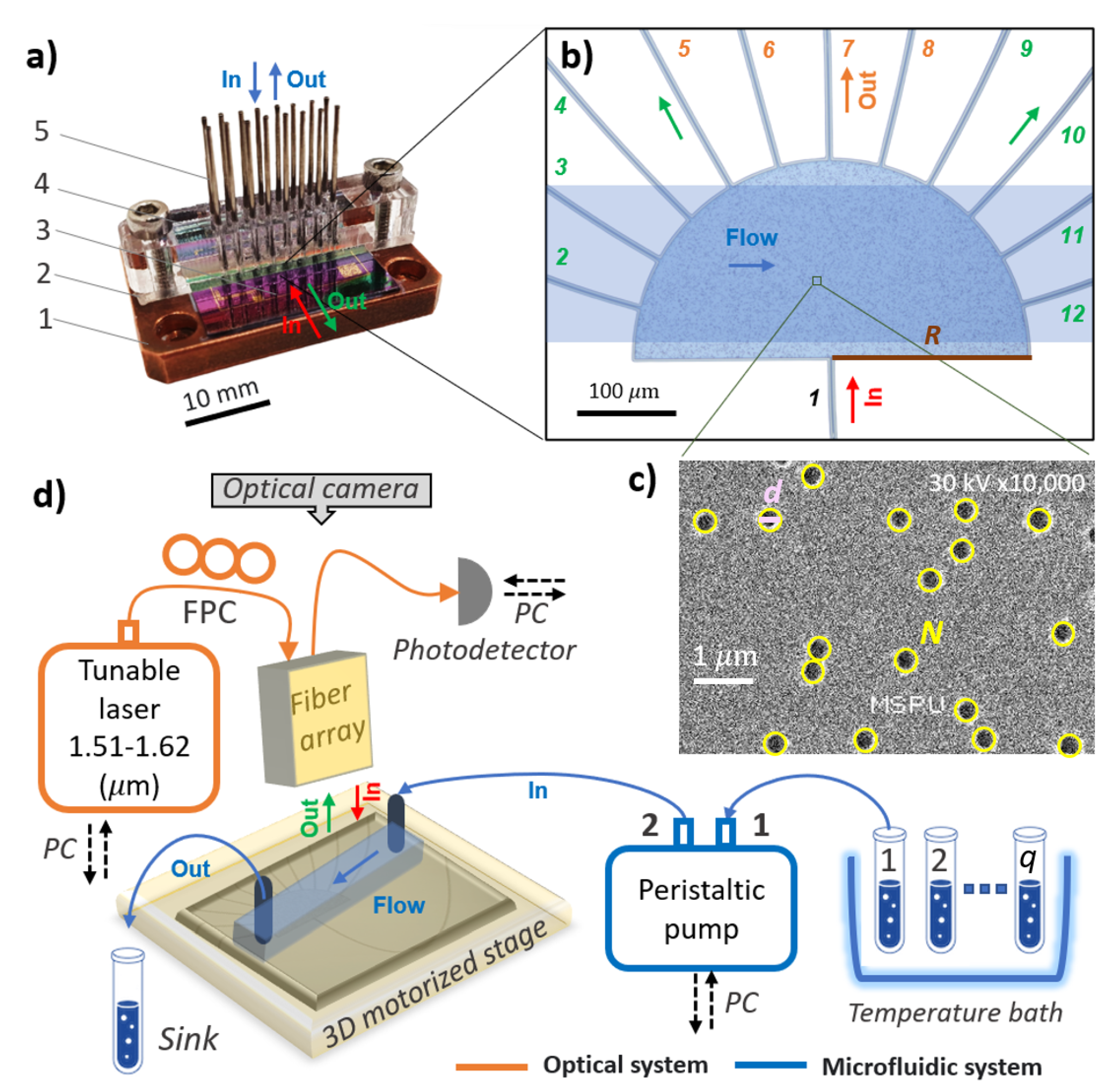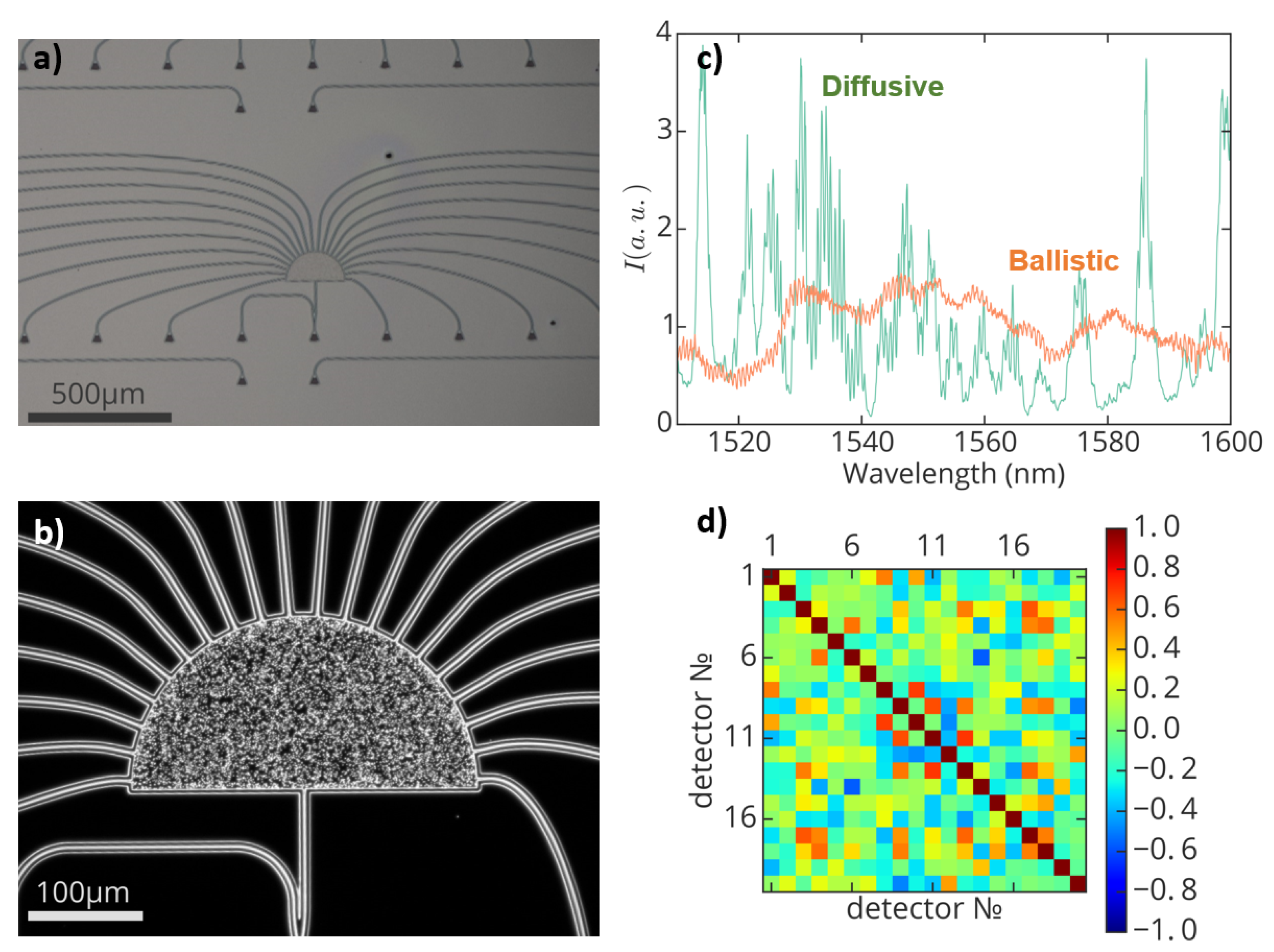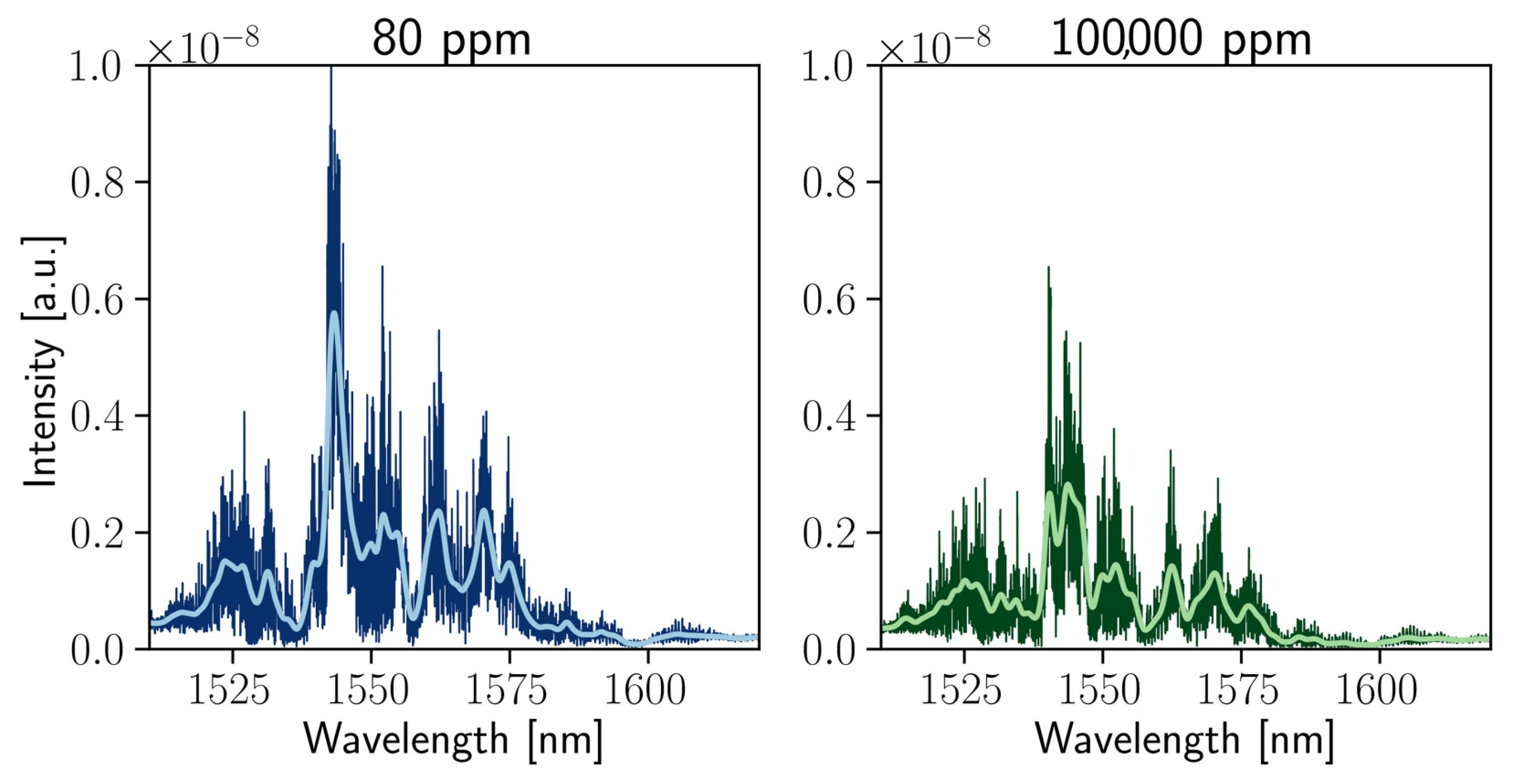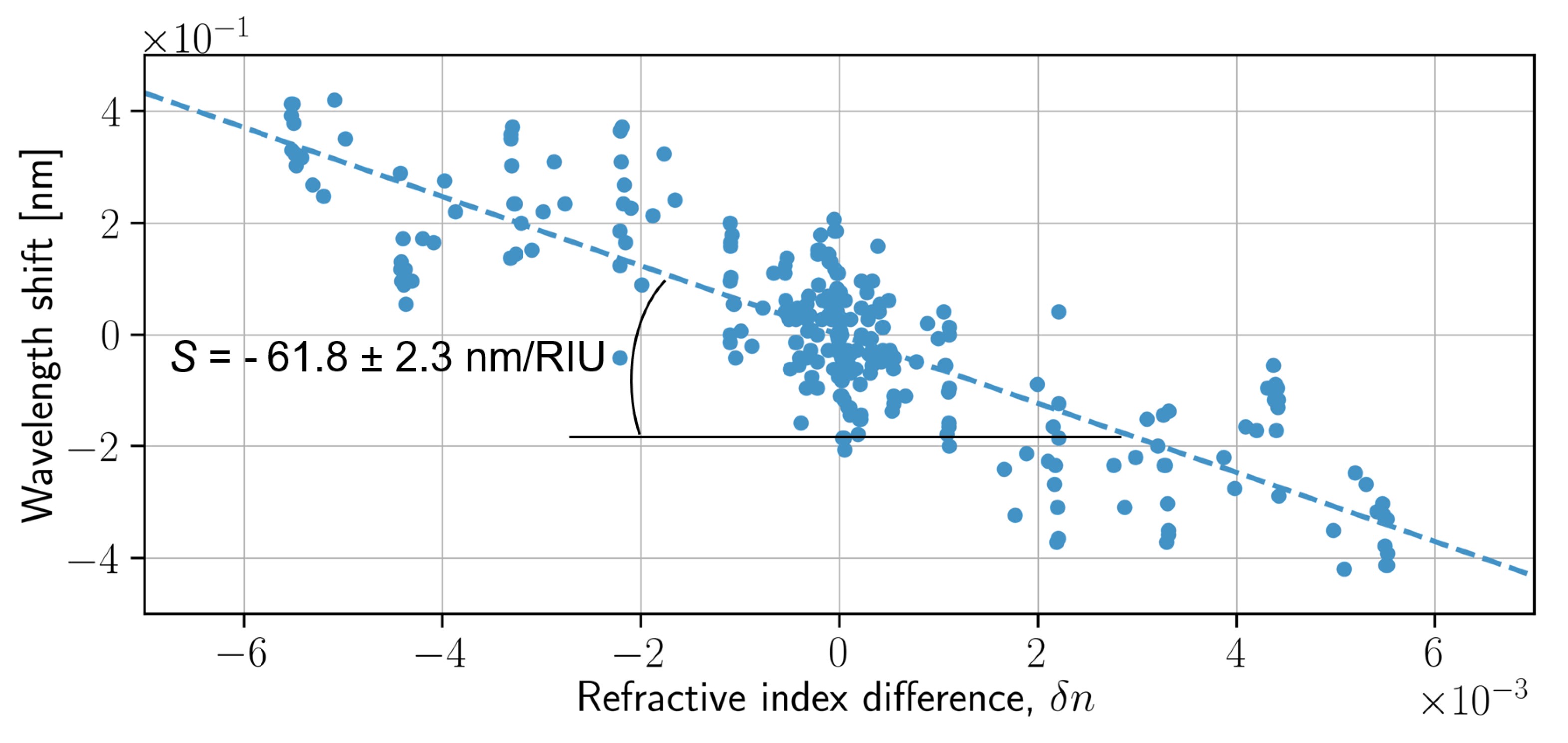Ultrasensitive Nanophotonic Random Spectrometer with Microfluidic Channels as a Sensor for Biological Applications
Abstract
1. Introduction
2. Materials and Methods
3. Results
3.1. Developing RDMX Design
3.2. Combination RDMX with MFCs
4. Discussion
5. Conclusions
Supplementary Materials
Author Contributions
Funding
Institutional Review Board Statement
Informed Consent Statement
Data Availability Statement
Conflicts of Interest
Abbreviations
| NRSM | Nanophotonic Random Spectrometer and Microfluidics |
| POC | Point-of-Care |
| QCM | Quartz Crystal Microbalance |
| SAW | Surface Acoustic Wave |
| PICs | Photonic Integrated Circuits |
| LOD | Limit of Detection |
| MRRs | Microring Resonators |
| MZIs | Mach–Zehnder Interferometers |
| AWGs | Arrayed Waveguide Gratings |
| PDMS | Polydimethylsiloxane |
| FGC | Focusing Grating Coupler |
| RIE | Reactive and Ion Etching |
| MFCs | Microfluidic Channels |
| RDMX | Random Demultiplixer |
References
- Chin, C.D.; Linder, V.; Sia, S.K. Commercialization of microfluidic point-of-care diagnostic devices. Lab Chip 2012, 12, 2118–2134. [Google Scholar] [CrossRef] [PubMed]
- Lv, C.; Hu, C.; Luo, J.; Liu, S.; Qiao, Y.; Zhang, Z.; Song, J.; Shi, Y.; Cai, J.; Watanabe, A. Recent advances in graphene-based humidity sensors. Nanomaterials 2019, 9, 422. [Google Scholar] [CrossRef] [PubMed]
- Blank, T.A.; Eksperiandova, L.P.; Belikov, K.N. Recent Trends of Ceramic Humidity Sensors Development: A Review. Sens. Actuators B Chem 2016, 228, 416–442. [Google Scholar]
- Dastgeer, G.; Shahzad, Z.M.; Chae, H.; Kim, Y.H.; Ko, B.M.; Eom, J. Bipolar Junction Transistor Exhibiting Excellent Output Characteristics with a Prompt Response against the Selective Protein. Adv. Funct. Mater. 2022, 32, 2204781. [Google Scholar] [CrossRef]
- Manikandan, V.; Sikarwar, S.; Yadav, B.C.; Mane, R.S. Fabrication of tin substituted nickel ferrite (Sn-NiFe2O4) thin film and its application as opto-electronic humidity sensor. Sens. Actuators A Phys. 2018, 272, 267–273. [Google Scholar] [CrossRef]
- Yao, Y.; Ma, W. Self-Assembly of Polyelectrolytic/Graphene Oxide Multilayer Thin Films on Quartz Crystal Microbalance for Humidity Detection. IEEE Sens. J. 2014, 14, 4078–4084. [Google Scholar] [CrossRef]
- Zhou, G.; Byun, J.-H.; Oh, Y.; Jung, B.-M.; Cha, H.-J.; Seong, D.-G.; Um, M.-K.; Hyun, S.; Chou, T.-W. Highly Sensitive Wearable Textile-Based Humidity Sensor Made of High-Strength, Single-Walled Carbon Nanotube/Poly(vinyl alcohol) Filaments. ACS Appl. Mater. Interfaces 2017, 9, 4788–4797. [Google Scholar] [CrossRef] [PubMed]
- Dastgeer, G.; Afzal, A.M.; Jaffery, S.H.A.; Imran, M.; Assiri, M.A.; Nisar, S. Gate modulation of the spin current in graphene/WSe2 van der Waals heterostructure at room temperature. J. Alloy. Compd. 2022, 919, 165815. [Google Scholar] [CrossRef]
- Altug, H.; Oh, S.H.; Maier, S.A.; Homola, J. Advances and applications of nanophotonic biosensors. Nat. Nanotechnol. 2022, 17, 5–16. [Google Scholar] [CrossRef] [PubMed]
- Kuzin, A.; Chernyshev, V.; Kovalyuk, V.; An, P.; Golikov, A.; Goltsman, G.; Gorin, D. In Situ Monitoring of Layer-by-Layer Assembly Surface Modification of Nanophotonic-Microfluidic Sensor. Anal. Chem. 2022, 94, 14517–14521. [Google Scholar] [CrossRef] [PubMed]
- Kuzin, A.; Chernyshev, V.; Kovalyuk, V.; An, P.; Golikov, A.; Ozhegov, R.; Gorin, D.; Gippius, N.; Goltsman, G. Hybrid nanophotonic–microfluidic sensor for highly sensitive liquid and gas analyses. Opt. Lett. 2022, 47, 2358–2361. [Google Scholar] [CrossRef] [PubMed]
- Cheben, P.; Schmid, J.H.; Delâge, A.; Densmore, A.; Janz, S.; Lamontagne, B.; Lapointe, J.; Post, E.; Waldron, P.; Xu, D.X. A high-resolution silicon-on-insulator arrayed waveguide grating microspectrometer with sub-micrometer aperture waveguides. Opt. Express 2007, 15, 2299–2306. [Google Scholar] [CrossRef] [PubMed]
- Cao, H. Perspective on speckle spectrometers. J. Opt. 2017, 19, 060402. [Google Scholar] [CrossRef]
- Kuzin, A.; Kovalyuk, V.; Golikov, A.; Prokhodtsov, A.; Marakhin, A.; Ferrari, S.; Pernice, W.; Gippius, N.; Goltsman, G. Efficiency of focusing grating couplers versus taper length and angle. J. Phys. Conf. Ser. 2019, 1410, 012181. [Google Scholar]
- Varytis, P.; Huynh, D.N.; Hartmann, W.; Pernice, W.; Busch, K. Design study of random spectrometers for applications at optical frequencies. Opt. Lett. 2018, 43, 3180–3183. [Google Scholar] [CrossRef] [PubMed]
- Redding, B.; Liew, S.F.; Sarma, R.; Cao, H. Compact spectrometer based on a disordered photonic chip. Nat. Photonics 2013, 7, 746–751. [Google Scholar] [CrossRef]
- Hariharan, P. Basics of Interferometry; Elsevier: Amsterdam, The Netherlands, 2010. [Google Scholar]
- Garcia-Merino, J.A.; Mercado-Zúñiga, C.; Torres-Sanmiguel, C.R.; Torres-Torres, C. Mechano-optical effects in multiwall carbon nanotubes ethanol based nanofluids. Opt. Express 2018, 26, 2033–2038. [Google Scholar] [CrossRef] [PubMed]
- Komma, J.; Schwarz, C.; Hofmann, G.; Heinert, D.; Nawrodt, R. Thermo-optic coefficient of silicon at 1550 nm and cryogenic temepratures. Appl. Phys. Lett. 2012, 101, 041905. [Google Scholar] [CrossRef]
- Elshaari, A.W.; Zadeh, I.E.; Jöns, K.D.; Zwiller, V. Thermo-optic characterization of silicon nitride resonators for cryogenic photonic circuits. IEEE Photonics J. 2016, 8, 1–9. [Google Scholar] [CrossRef]





Disclaimer/Publisher’s Note: The statements, opinions and data contained in all publications are solely those of the individual author(s) and contributor(s) and not of MDPI and/or the editor(s). MDPI and/or the editor(s) disclaim responsibility for any injury to people or property resulting from any ideas, methods, instructions or products referred to in the content. |
© 2022 by the authors. Licensee MDPI, Basel, Switzerland. This article is an open access article distributed under the terms and conditions of the Creative Commons Attribution (CC BY) license (https://creativecommons.org/licenses/by/4.0/).
Share and Cite
Kuzin, A.; Fradkin, I.; Chernyshev, V.; Kovalyuk, V.; An, P.; Golikov, A.; Florya, I.; Gippius, N.; Gorin, D.; Goltsman, G. Ultrasensitive Nanophotonic Random Spectrometer with Microfluidic Channels as a Sensor for Biological Applications. Nanomaterials 2023, 13, 81. https://doi.org/10.3390/nano13010081
Kuzin A, Fradkin I, Chernyshev V, Kovalyuk V, An P, Golikov A, Florya I, Gippius N, Gorin D, Goltsman G. Ultrasensitive Nanophotonic Random Spectrometer with Microfluidic Channels as a Sensor for Biological Applications. Nanomaterials. 2023; 13(1):81. https://doi.org/10.3390/nano13010081
Chicago/Turabian StyleKuzin, Aleksei, Ilia Fradkin, Vasiliy Chernyshev, Vadim Kovalyuk, Pavel An, Alexander Golikov, Irina Florya, Nikolay Gippius, Dmitry Gorin, and Gregory Goltsman. 2023. "Ultrasensitive Nanophotonic Random Spectrometer with Microfluidic Channels as a Sensor for Biological Applications" Nanomaterials 13, no. 1: 81. https://doi.org/10.3390/nano13010081
APA StyleKuzin, A., Fradkin, I., Chernyshev, V., Kovalyuk, V., An, P., Golikov, A., Florya, I., Gippius, N., Gorin, D., & Goltsman, G. (2023). Ultrasensitive Nanophotonic Random Spectrometer with Microfluidic Channels as a Sensor for Biological Applications. Nanomaterials, 13(1), 81. https://doi.org/10.3390/nano13010081







